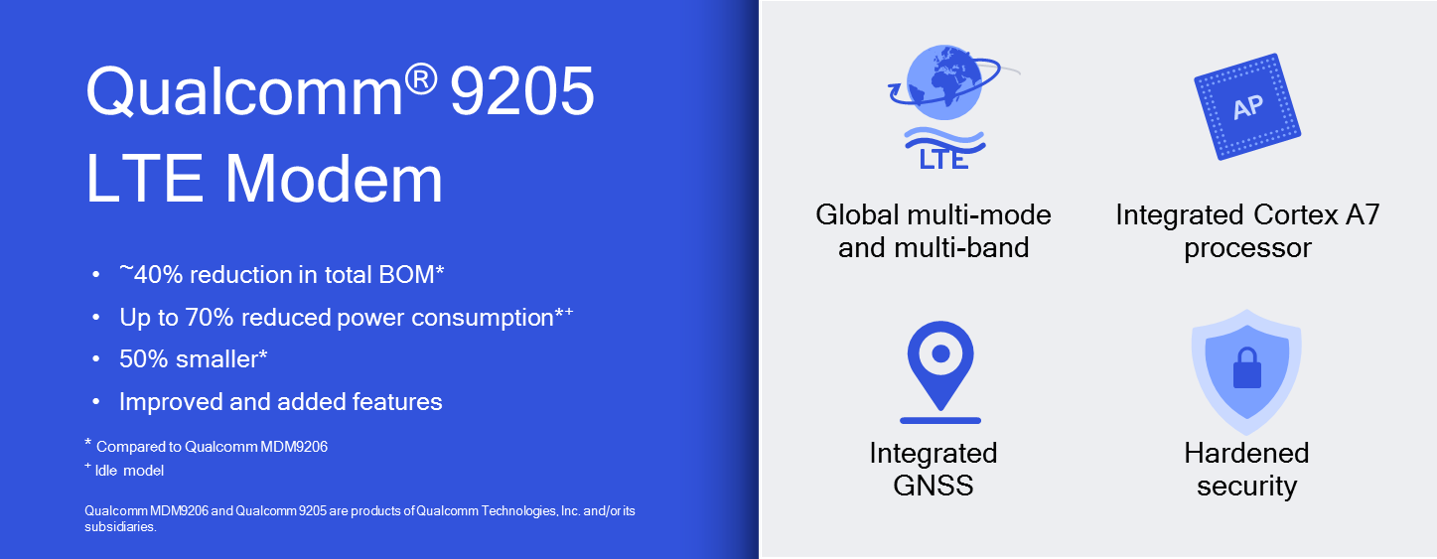Qualcomm Technologies, Inc. a subsidiary of Qualcomm Incorporated, today announced its next-generation modem purpose-built for Internet of Things (IoT) applications such as asset trackers, health monitors, security systems, smart city sensors and smart meters, as well as a range of wearable trackers. The new Qualcomm® 9205 LTE modem is unique in bringing together key innovations required to build cellular-enabled IoT products and services in a single chipset, including global multimode LTE category M1 (eMTC) and NB2 (NB-IoT) as well as 2G/E-GPRS connectivity, application processing, geolocation, hardware-based security, support for cloud services and accompanying developer tools.
Compared to its predecessor, the modem is engineered to reduce power consumption by up to 70% in idle mode, a critical consideration for battery-powered IoT devices that need to operate for 10 years or longer in the field. The Qualcomm 9205 LTE modem is also 50% smaller and more cost-effective than its predecessor – making it ideal for IoT applications requiring low-power, wide-area connectivity in a small form factor device. The new modem is also software-compatible with the Company’s prior LTE IoT solutions which allows module manufacturers to reuse software investments to develop new module solutions.
“The innovations included in the Qualcomm 9205 LTE modem are critical to support many of the 6 billion IoT devices expected to use low-power, wide-area connectivity by 2026,” said Vieri Vanghi, vice president, product management, Qualcomm Europe, Inc. “LTE IoT technologies are the foundation of how 5G will help connect the massive IoT, and we are making these technologies available to customers worldwide to help them build innovative solutions that can help transform industries and improve people’s lives.”
Qualcomm 9205 LTE modem technology highlights
Global multimode LTE IoT modem and connectivity: Support for both 3GPP release 14 Category M1 and NB2 for operation with networks using any of these LTE IoT modes, as well as 2G/E-GPRS to allow for connectivity in areas where LTE IoT is not yet deployed. Category M1 mode also supports voice for applications such as monitored security panels, and mobility for applications such as asset trackers.
RF transceiver with fully integrated front-end: The Qualcomm 9205 LTE modem features an RF transceiver with extended bandwidth support from 450 MHz to 2100 MHz. It also integrates a comprehensive RF front-end, a commercial first in the cellular IoT space, which is designed to greatly simplify the design and certification of products using the new modem, and therefore accelerate time to commercialization.
Advanced battery life management: To maximize battery life, the modem couples ultra-low system-level cut-off voltage with provisions for adapting power usage according to the state of charge of the battery.
Applications processor: Arm Cortex A7 up to 800MHz with support for ThreadX and AliOS Things real-time operating systems. The integrated applications processor avoids the need for an external microcontroller to improve cost-efficiency, and device security.
Geolocation: Integrated global positioning support for Global Navigation Satellite Systems (GNSS) including GPS, Beidou, Glonass, and Galileo. The Qualcomm 9205 LTE modem enables design flexibility allowing for the use of either a shared GNSS/LTE antenna or a dedicated one.
Hardware-based security: Secure boot from hardware root-of-trust, Qualcomm® Trusted Execution Environment, hardware cryptography, storage, and debug security.
LTE IoT Software Development Kit (SDK): Designed to support developers in running custom software on the integrated applications processor, as well as to provide them access to additional capabilities of the Qualcomm 9205 LTE modem, such as geolocation. The SDK offers pre-integrated support for many cloud platforms, including Alibaba Cloud Link One, China Mobile OneNET, DTSTON DTCloud, Ericsson IoT Accelerator, Gizwits and Verizon ThingSpace, and it also allows developers to extend this integration further and develop support for other major IoT cloud providers.
“The Qualcomm 9205 modem is expanding the IoT ecosystem by providing a solid foundation for future-proof, multimode LTE-M and NB-IoT Cinterion Modules designed to enable superior worldwide LPWAN connectivity as networks evolve,” said Andreas Haegele, SVP IoT products, Gemalto. “Our security enhancements provide a strong framework for unique Gemalto services such as Device Lifecycle Management that help drive down TCO for device makers and IoT service providers.”
“The new Qualcomm 9205 LTE modem is unique in integrating the critical technologies that our customers would need to create cellular-connected IoT solutions,” said Doron Zhang, senior vice president, Quectel. “All its features are put together in a tiny and very energy-efficient chipset that will help Quectel to offer LTE IoT modules that are powerful, economical and with support for superb battery life.”
“The multimode, highly integrated capabilities of the Qualcomm 9205 LTE modem allow us to reduce power consumption and module footprint giving our customers the ability to design and deploy smaller, battery-powered devices that work worldwide on virtually any cellular IoT network,” said Manish Watwani, executive vice president, global product management, Telit. “As a global company, we build on Qualcomm Technologies’ innovations to deliver modules and IoT edge solutions used by companies around the world to improve productivity and deliver exciting new applications.”
The Qualcomm 9205 LTE modem builds on the commercial success of its predecessor which counts more than 110 design-wins to date. Solutions based on the new modem, including modules from Gemalto, Quectel and Telit, are expected to be commercially available in 2019. For more information please visit https://www.qualcomm.com/products/qualcomm-9205-lte-modem.



















